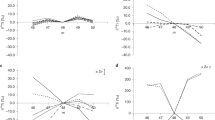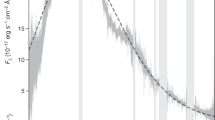Abstract
SEVERAL explanations1–4 of the excess 129Xe and 131Xe in terrestrial tellurium ores have been proposed. Takagi et al.2 pointed out that the observed 129Xe/131Xe ratios are well explained by muon interactions on tellurium isotopes. The intense muon flux necessary for the production of the observed amount of the xenon isotopes was considered to have been produced through the resonant scattering of high energy electron antineutrinos emitted by the explosion of our galaxy. Since that paper there has been some further analytical data on the isotopic composition of xenon in tellurides4, which essentially seem to be consistent with the explosion mechanism.
This is a preview of subscription content, access via your institution
Access options
Subscribe to this journal
Receive 51 print issues and online access
$199.00 per year
only $3.90 per issue
Buy this article
- Purchase on Springer Link
- Instant access to full article PDF
Prices may be subject to local taxes which are calculated during checkout
Similar content being viewed by others
References
Inghram, M. G., and Reynolds, J. H., Phys. Rev., 78, 822 (1950).
Takagi, J., Sakamoto, K., and Tanaka, S., J. Geophys. Res., 72, 2267 (1967).
Kirsten, T., Gentner, W., Gentner, W., and Müller, O., Z. Naturforsch., 22a, 1783 (1967).
Alexander, jun., E. C., Srinivasan, B., and Manuel, O. L., Earth Plan. Sci. Lett., 5, 478 (1969).
Jeffery, P. M., and Hagan, P. J., Nature, 223, 1253 (1969).
Emerson, D. E., Stroud, L., and Meyer, T. O., Geochim. Cosmochim. Acta, 30, 847 (1968).
Clarke, W. B., and Beg, M. A., Earth Plan. Sci. Lett., 6, 213 (1969).
Wyckoff, J. M., Ziegler, B., Kock, W. W., and Uhlig, K., Phys. Rev., 137, B576 (1965).
Nascimento, I. C., Moscati, G., and Goldenberg, J., Nucl. Phys., 22, 484 (1961).
Heinrich, F., and Wäffler, H., Helv. Phys. Acta, 29, 233 (1956).
Wetherill, G. W., Phys. Rev., 96, 679 (1954).
Fleming, W. H., and Thode, H. G., Phys. Rev., 90, 857 (1953).
Author information
Authors and Affiliations
Rights and permissions
About this article
Cite this article
TAKAGI, J. Physical Sciences: Rare Gas Anomalies and Intense Muon Fluxes in the Past. Nature 227, 362–363 (1970). https://doi.org/10.1038/227362a0
Received:
Revised:
Issue Date:
DOI: https://doi.org/10.1038/227362a0
This article is cited by
-
Cosmogenic helium in a terrestrial igneous rock
Nature (1986)
-
Chapter 4 General problems of tectonics and volcanism of island arcs and associated tectonic systems
Bulletin Volcanologique (1979)
-
Origin of Ne21 isotopes in radioactive minerals
Soviet Atomic Energy (1971)
Comments
By submitting a comment you agree to abide by our Terms and Community Guidelines. If you find something abusive or that does not comply with our terms or guidelines please flag it as inappropriate.



